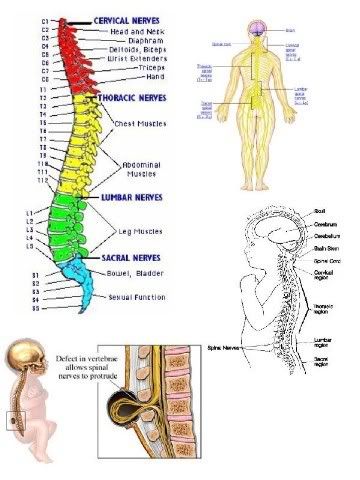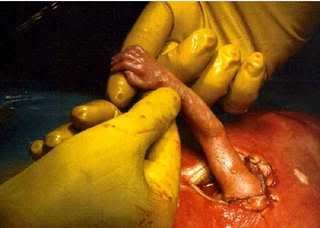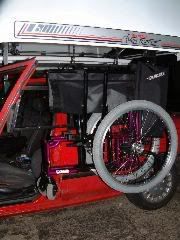I wrote this for my MySpace blog in 2007 but realized I could educate more people if I added it at my Xanga blog. It has now been transferred here. Is that like blog laundering? I don’t I know. At any rate, thought this would be educational. Jamie
“Can you have sex?” (and other questions people ask)
I think I was in about fifth or sixth grade when it happened. My Sunday School teacher (yes, my Sunday School teacher) was talking to me about my disability in a one-on-one conversation. She really did ask me if I’m able to have sex.
I’ve been asked a lot over the years about my disability. Most the time it doesn’t offend me, although sometimes the questions reek of unthinking ignorance. Most the time people are just curious or they want to learn about me so I try to answer the questions the best I can. Something I’ve found over the years, however, is that most people don’t want to be nosy or rude so they let many natural and common questions go unasked.
Well, October is National Spina Bifida Awareness Month so I thought I’d help ya’ll become more aware of my disability by answering some of the questions I get the most. If you have other questions, ask them in the comments. I’ve answered a large number of these questions using verbage and data from the Spina Bifida Association of America.
Now for the questions (in order of what I can remember them):
What is Spina Bifida?
Spina Bifida is a birth defect that happens when part of the baby’s spine fails to close properly during the first month or so of the mother’s pregnancy. SB is referred to as a neural tube defect. Surgery to close a newborn’s back is generally performed within 24 hours after birth to minimize the risk of infection and to preserve existing function in the spinal cord. I had this surgery and have a noticeable scar from it. Unfortunately because I sit down most the time, the back of my pants often slides down giving me “plumber’s crack” if I’m not careful. My scar looks like it’s at the top part of the crack even though it’s technically higher than that.
Are there different types of Spina Bifida?
Yes, there are three different types. I have the most severe form. The three forms are:
* Occulta—Often called hidden Spina Bifida, the spinal cord and the nerves are usually normal and there is no opening on the back. There may be no motor or sensory impairments evident at birth. Subtle, progressive neurologic deterioration often becomes evident in later childhood or adulthood.
* Meningocele–The protective coatings (meninges) come through the open part of the spine like a sac that is pushed out. Cerebrospinal fluid is in the sac and there is usually no nerve damage. Individuals may suffer minor disabilities. Additional problems can develop later in life.
* Myelomeningocele (which is what I was born with)–This form of Spina Bifida occurs when the meninges (protective covering of the spinal cord) and spinal nerves come through the open part of the spine. This is the most serious type of Spina Bifida, which causes nerve damage and more severe disabilities.
What causes Spina Bifida?
There is no absolutely known cause for Spina Bifida but extensive study has shown that somehow a folic acid decificiency in the mother can often be a contributing factor. This is why women who are sexually active and of child-bearing age (even if you’re using birth control!) are encouraged to take a small dose of folic acid every day. Spina Bifida usually occurs before the woman realizes she’s pregnant so it would be too late to start taking the folic acid after realizing you’re pregnant.One thing I must stress is that it’s not the mother’s fault if the baby develops Spina Bifida. This is another question I’ve had … “what did your mother do to make you like this,” etc.
I should also add that many children of victims of Agent Orange during the Vietnam War also have Spina Bifida. I have no idea what the connection is though.
Is it inherited?
Well, sorta. Not exactly. Women with Spina Bifida have a higher risk rate of having a baby with Spina Bifida compared to women who don’t have SB. But women with SB have healthy babies every day. There is often a family history of SB but there can also be no family history (my mother had no family history that we’re aware of).
Can I catch Spina Bifida?
Short answer … no. It’s a birth defect. If you would like for me to sneeze on you to prove my point, I would be happy to do so!
How common is Spina Bifida?
“Spina Bifida occurs in 7 out of every 10,000 live births in the United States. Birth certificate data from the National Vital Statistics System, a component of the Centers for Disease Control and Prevention (CDC), National Center for Health Statistics (NCHS), indicate a drop in the rate of Spina Bifida; however, Spina Bifida is considered to be underreported on birth certificates so the drop in the rate could be due to lack of reporting, not an actual decrease in occurrence. In addition, a number of Spina Bifida pregnancies are voluntarily terminated and we cannot be certain how many pregnancies are terminated versus carried to term.” When I was born, the chances of SB were more like 1 in a 1,000, but I don’t remember exactly. Preventative measures, bad reporting and abortion have all contributed to the current decreased rate.
What happens to a person with Spina Bifida?
It varies based on a lot of factors. The biggest factor is where the opening to the spine is located. Take a look at the following graphic and it will sort of explain it. 
Because of the paralysis resulting from the damage to the spinal cord, people born with Spina Bifida may need surgeries and other extensive medical care. The condition can also cause bowel and bladder complications. I have to see specialists somewhat frequently and I’ve had a total of 15 surgeries, which is actually a small number compared to others with Spina Bifida.When I was a kid I had a total of like 6-7 doctors that I saw regularly. A large percentage of children born with Spina Bifida also have hydrocephalus, the accumulation of fluid in the brain. Hydrocephalus is controlled by a surgical procedure called “shunting” which relieves the fluid build up in the brain by pumping it into the abdominal area. I have a shunt, which is why I’m so overprotective of stuff hitting my head. If the shunt is damaged, it could kill me.
A large number of people with Spina Bifida also have a non-verbal learning disability, which causes various issues that don’t necessarily have to do with actual learning. Check the link to find out more about NVLD. It’s an old blog I wrote this summer.
How long have you had Spina Bifida?
It was a doctor who asked me this, I kid you not. A birth defect means I’ve had it since I was born. That would mean I’ve had it my whole life.
If you could walk before, why can’t you walk now?
This is both complicated and mildly embarrassing. The truth is, I used to be able to walk. My gait was like a drunken pregnant chimpanzee, but I could walk short distances. I used a wheelchair for long distances such as in the shopping mall. Here’s a shot of me when I was 9 years old…you can sort of see how I used my arms for balance.

Anyways, I’ve always been told that I would eventually go to a chair full time. The unnatural way that I walked and had to use my body made it wear and tear faster than a normal person’s would. But that’s not why I went to the chair. The truth is, I put on too much weight to be able to walk. I don’t expect to be able to walk again now that I’m losing weight. No, I’m not upset. I feel much more comfortable and confident in my wheelchair.
Is there a cure?
No. There are many advancements to make life longer and better for people with Spina Bifida, but there is no cure.
How can it be prevented?
The only preventative measure I’m aware of is taking the folic acid. If a doctor tells you it isn’t necessary, switch doctors because he/she is an idiot.
What advancements have been made to help people with Spina Bifida?
Honestly, I don’t know a lot. It used to be that a lot of people with SB didn’t survive for one reason or another. It can still happen. People my age even die during surgery, of infections, etc. But dying is much less common. There have been a lot of improvements in the leg braces, surgical procedures, shunt styles, etc. For example, they have programmable shunts now where they can be changed electronically somehow instead of requiring surgery every time an adjustment has to be made. There is also a fetal surgery that I’m not sure if they still do where they open the woman up during the latter part of the pregnancy and close the spine up then put the baby back in the uterus to let the baby “bake” longer. Closing the spine in utero doesn’t cure the Spina Bifida but it reduced the amount of damage done to the exposed spinal chord that could happen during delivery and the last months of pregnancy because of the baby being in such a tight spot.
The surgery isn’t exactly like this, but it will give you an idea…


Can you drive?
Yes, I can. In fact I don’t even use hand controls. My paralysis is only from the shins down. I can explain this better in person but anyways, I can drive. I do have hand controls installed on my car but I don’t need them and I don’t use them.
I do use a chair topper to store my chair when I’m in the car. I get a lot of questions about the chair topper and a lot of goofy comments but it’s a good tool to have. Here it is on my old car

Do you mind having Spina Bifida?
I honestly don’t. I’m not going to lie, sometimes it’s frustrating to deal with some of its effects and I do get tired of the discrimination, even the positive discrimination. But overall I strongly believe that God made me this way for a reason. This is something I wrote about having Spina Bifida on a Web site I used to operate:
What is Spina Bifida? First of all, I will tell you what it’s not. Spina Bifida is not a disease. And it definitely doesn’t mean life is over. Life will be different for a baby born with SB but different doesn’t mean that life can’t be fulfilling. We are still complete human beings with emotions, thoughts, sexuality and a soul.
Everything happens for a reason. There are reasons God allowed me to be born with SB. Some I don’t know yet because they have yet to be revealed.
One of the reasons I believe I was born the way I am and to the parents I was born to is because it provided an opportunity for a family to show faith, strength and love in the face of adversity. It also gave our family a chance to show God’s love.
There is a quote my mom told me a long time ago and it’s on my home page. I now know it’s called the serenity prayer. It reads: “God grant us the serenity to accept the things we cannot change, courage to change the things we can and wisdom to know the difference.”
There are many problems I can change or at least improve. Spina Bifida isn’t one of them. In all honestly, if I had the chance, I don’t think I would change the fact that I have SB. Sound weird? Well, I would change the internal health issues but I don’t mind that my legs don’t work the same as other people. There are bigger things at stake, in my opinion.
I think that being disabled has taught me compassion and the ability to see life from a different point of view. THAT is so much more important than being able to participate in PE like the other kids or being able to get around with a lot of ease.


Jamie,
You are a great teacher. I had to laugh out loud about the doctor asking you how long you’ve had SB…that was funny. Why is it not even doctors remain educated about these things. Thanks for sharing about your life and your life story.
Blessings, ~Candy
I am amazed at some of the questions you have been asked, and even more yet amazed by who asked them! Thanks for the info!
Hi Jamie, I’ve wondered how you have been doing. Hope you have a Happy Thanksgiving. ~Candy
hi Jaime I was born with spina bifida as well. I thank you for this page because it educates people about how we live life. i have not yet began to drive but i would like more info on accomodations they have for cars thanx again
God Bless You
Jyndia
Jamie, I know this is an old blog post, but I hope you will see my comment. I am 21 weeks pregnant and just found out that my daughter has SB. Her doctor believes that it is sacral and small, but I am still so scared of how life will be for her. Of course I love her unconditionally already, I just want her life to be as easy as possible. Anyway, I really enjoyed reading what you had to say about having SB. It’s so wonderful to hear that you wouldn’t even want it gone. I was completely ignorant before my daughter’s diagnosis, but am now slowly starting to research to see what might be ahead for her. Thank you so much for sharing your story and giving me more hope. I also believe that God is placing this little girl into my family’s life for a reason. I love her so much already and I hope I can help her to become a strong and independent woman no matter what struggles she may face. God Bless!